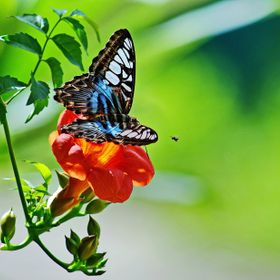A Black-naped Oriole flies to eat the fruit of a tamarind tree.
A Black-naped Oriole flies to eat the fruit of a tamarind tree.
Read less
Read less
Views
416
Likes
Peer Award
Absolute Masterpiece
Top Choice
Magnificent Capture
Superior Skill
Virtuoso
Outstanding Creativity
Top Ranks
Categories
Same photographer See allBehind The Lens
Discover more photos See all
Behind The Lens
Location
I stepped out on my front porch and saw this Black-napped Oriole flying up repeatedly to get a bite of tamarind fruit from a tree. I quickly got my camera, and luckily the bird hadn't finished eating and flew about three more times to get a nibble before it flew away. We rarely see a Black-napped Oriole around our house, so I was very fortunate to see it when I did and for it to continue eating long enough for me to get my camera and capture it.Time
It was 3:31 p.m. on a pleasant afternoon. It was a bit early in the day to catch a bird eating like this, and I was fortunate to see it and be able to photograph the action.Lighting
The lighting is natural sunlight, which is preferable with all nature photography.Equipment
This sighting was quite unexpected, so it was a case of quickly grabbing my camera and getting the shots before the bird finished eating. I normally have my Nikon D500 set up with a Nikkor 200-500mm zoom lens set in Manual at F8, 500th sec., and I'll adjust from there. Because the bird was in the shade of the tree, I only increased the shutter speed to 800th of a second, which kicked my ISO up to 2,800. If possible, I keep my ISO under 3,000 to eliminate grain.Inspiration
One of the photography challenges I place on myself is to get great "birds in flight" photos. I'm unable to travel, so most of my photography takes place within walking distance of my home. Therefore, it sometimes gets boring taking photos of the same species of bird, but I challenge myself to get better pictures. In this case, not only did I get some of the best "bird in flight" photos, the Black-napped Oriole is not commonly seen around my home.Editing
Other than cropping and perhaps a small tweak on lightening, what you see is pretty much right out of the camera.In my camera bag
I carry very little when I go out to take nature photos. I find that catching animals in nature happens so quickly that carrying a lot of equipment is pointless. In general, I only carry my Nikon D500 with either a Nikkor 200-500mm zoom or a Nikkor 18-300 mm zoom attached. I go with one lens in anticipation of how far away the subject I want to photograph may be. This sometimes causes me to miss shots, but even if I carried the other lens with me it is highly improbable I'd be able to switch lenses in time anyway.Feedback
Since I rarely have the opportunity to travel, most of my photography is local, with the majority of photos taken in my neighborhood. If you can't travel to exotic locations, you might be surprised by what you can find near your home if you consider leaning toward macro photography. There are thousands of very interesting and beautiful things to photograph, even if it is as small as a ladybug. When you open your awareness of what is right around your house, you may be surprised at the photo opportunities that are available.













































